Paper Menu >>
Journal Menu >>
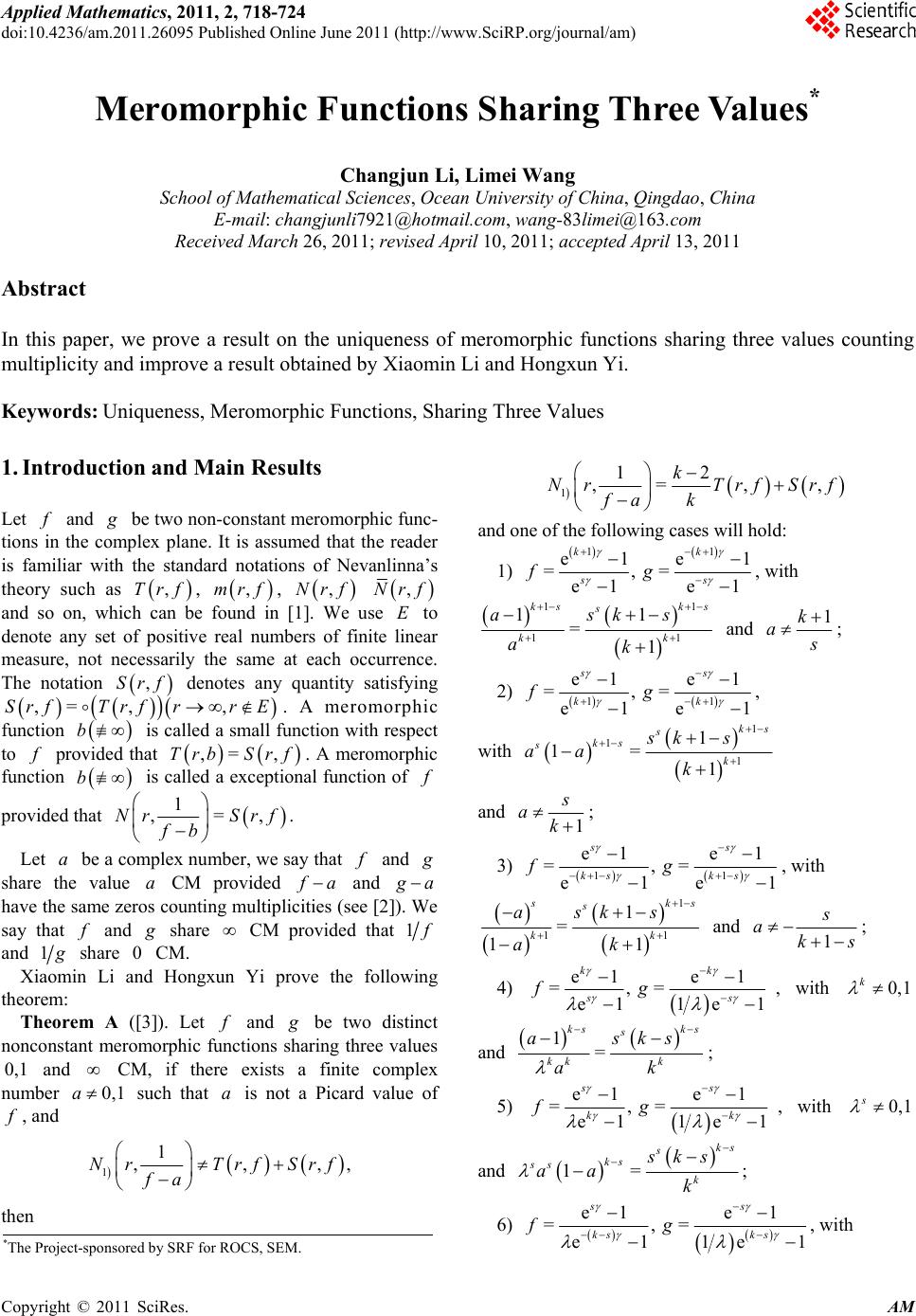 Applied Mathematics, 2011, 2, 718-724 doi:10.4236/am.2011.26095 Published Online June 2011 (http://www.SciRP.org/journal/am) Copyright © 2011 SciRes. AM Mer omorphic Functions Sharing Thr ee Values* Changjun Li, Limei Wang School of Mathemat i cal Sci ences, Ocean University of China, Qingdao, Chin a E-mail: changjunli7921@hotmail.com, wang-83limei@163.com Received March 26, 2011; revised April 10, 2011; accepted April 13, 2011 Abstract In this paper, we prove a result on the uniqueness of meromorphic functions sharing three values counting multiplicity and improve a result obtained by Xiaomin Li and Hongxun Yi. Keywords: Uniqueness, Meromorphic Functions, Sharing Three Values 1. Introductionand Main Results Let f and g be two non-constant meromorphic func- tions in the complex plane. It is assumed that the reader is familiar with the standard notations of Nevanlinna’s theory such as , ,Trf ,mrf , ,Nrf ,Nrf and so on, which can be found in [1]. We use to denote any set of positive real numbers of finite linear measure, not necessarily the same at each occurrence. The notation denotes any quantity satisfying . A meromorphic function E ,Srf ,rf r Srf ,r E ,=T b is called a small function with respect to f provided that Tr . A meromorphic function ,=b Sr ,f b is called a exceptional function of f provided that ,= ,Nr Srf fb 1 . Let be a complex number, we say that a f and g share the value a CM provided and af a g have the same zeros counting multiplicities (see [2]). We say that and f g share CM provided that 1 f and 1 g share 0 CM. Xiaomin Li and Hongxun Yi prove the following theorem: Theorem A ([3]). Let and f g be two distinct nonconstant meromorphic functions sharing three values and CM, if there exists a finite complex number such that a is not a Picard value of , and 0,1 f 0,1a 1 1 ,,NrTrfSrf fa ,, then 1 12 ,=, , k NrTrf Srf fa k and one of the following cases will hold: 1) 11 e1e =, = e1e 1 kk ss fg 1 , with 11 11 11 = 1 ks ks s kk asks ak and 1k a s ; 2) 11 e1e 1 =, = e1e ss kk fg 1 , with 1 1 1 1 1= 1 ks s ks s k sk s aa k and 1 s ak ; 3) 11 e1e1 =, = e1e ss ks ks fg 1 , with 1 11 1 = 11 s ks s kk asks ak and 1 s aks ; 4) e1e 1 =, = e11e 1 kk ss fg , with and 0,1 k 1= ks ks s kk k asks ak ; 5) e1e 1 =, = e11e 1 ss kk fg , with and 0,1 s 1= ks s ks ss k sks aa k ; 6) e1e1 =, = e11e ss ks ks fg 1 , with *The Project-sponsored by SRF for ROCS, SEM. 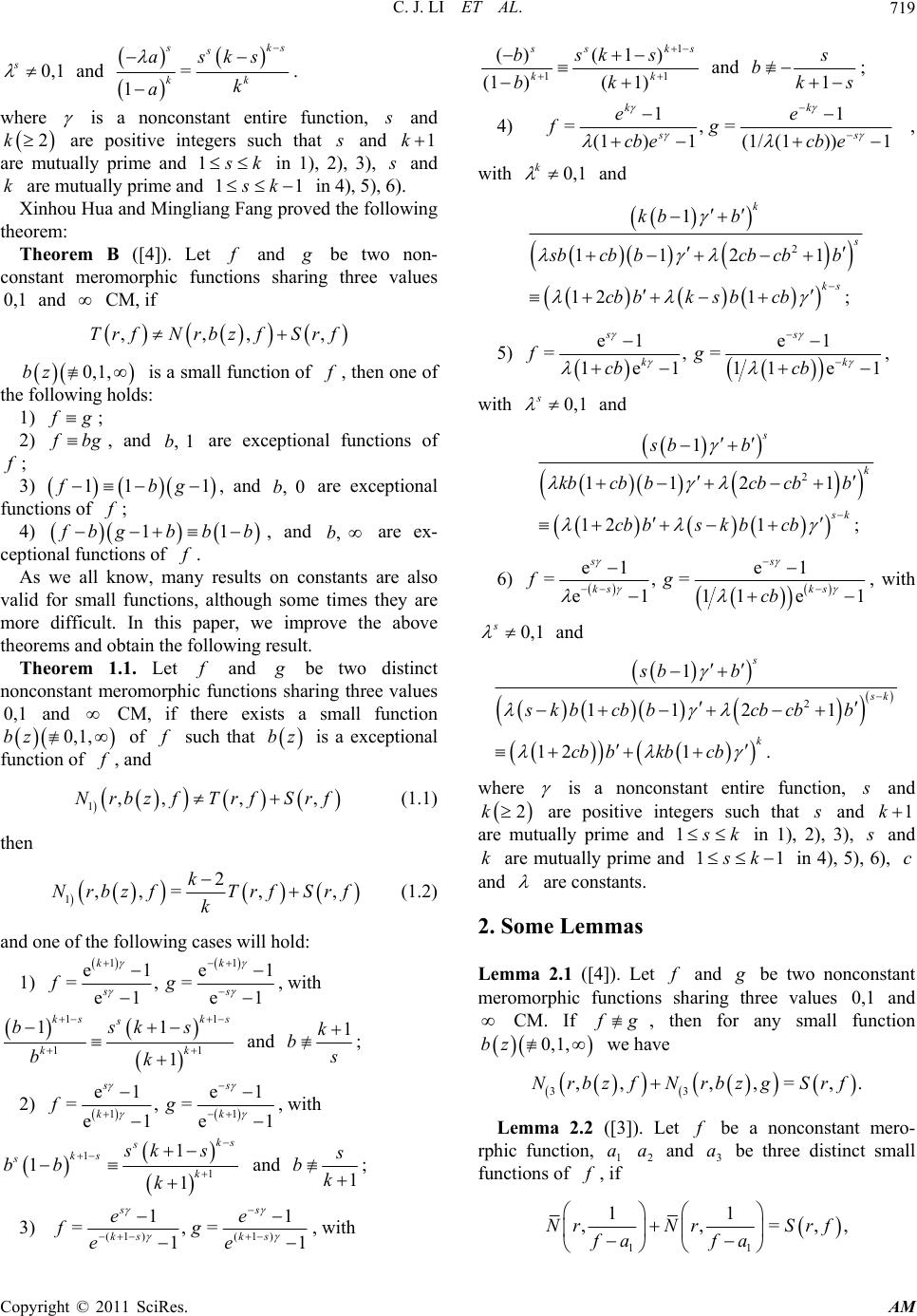 C. J. LI ET AL.719 s0,1 and = 1 s ks s kk asks k a . where is a nonconstant entire function, s and are positive integers such that 2k s and 1 k are mutually prime and ks 1 in 1), 2), 3), s and are mutually prime and k11 ks in 4), 5), 6). Xinhou Hua and Mingliang Fang proved the following theorem: Theorem B ([4]). Let f and g be two non- constant meromorphic functions sharing three values and CM, if 0,1 ,,,TrfNrbz fSrf, 0,1,bz is a small function of , then one of the following holds: f 1) f g; 2) f bg, and are exceptional functions of , 1b f ; 3) , and are exceptional functions of f 11 1g b , 0b f ; 4) 1 1 f bgb bb f, and are ex- ceptional functions of . , b As we all know, many results on constants are also valid for small functions, although some times they are more difficult. In this paper, we improve the above theorems and obtain the following result. Theorem 1.1. Let and f g be two distinct nonconstant meromorphic functions sharing three values and CM, if there exists a small function of such that is a exceptional function of , and 0,1 bz 1,f 0, f bz 1,,, ,NrbzfTrf Srf (1.1) then 1 2 ,,=, , k NrbzfTrf Srf k (1.2) and one of the following cases will hold: 1) 11 e1e =, = e1e 1 kk ss fg 1 , with 11 11 11 1 ks ks s kk bsks bk and 1k b s ; 2) 11 e1e 1 =, = e1e ss kk fg 1 , with 1 1 1 1 1 ks s ks s k sk s bb k and 1 s bk ; 3) 1 1 =, 1 1 =)1()1( sk s sk s e e g e e f, with 1 1 11)( )1( )(1 )( k sks k s k sks b b and sk s b 1; 4) 1))(1(1/ 1 =, 1)(1 1 = s k s k ecb e g ecb e f, with and 0,1 k 2 1 112 1 121 ; k s ks kb b s bcbbcb cbb cb bks bcb 5) e1e 1 =, = 1e1 11e1 ss kk fg cb cb , with and 0,1 s 2 1 112 1 121 ; s k sk sb b kbcbbcb cbb cb bskbcb 6) e1e 1 =, = e111e ss ks ks fg cb 1 , with and 0,1 s 2 1 112 1 121 . s s k k sb b sk bcbbcbcbb cb bkbcb where is a nonconstant entire function, s and 2k are positive integers such that s and 1k are mutually prime and ks 1 in 1), 2), 3), s and are mutually prime and in 4), 5), 6), and k1k1 sc are constants. 2. Some Lemmas Lemma 2.1 ([4]). Let and f g be two nonconstant meromorphic functions sharing three values and 0,1 CM. If gf , then for any small function 0,1,bz we have 33 ,, ,,=,NrbzfNrbzg Srf. Lemma 2.2 ([3]). Let be a nonconstant mero- rphic function, 1 and be three distinct small functions of , if faa 2 a3 f 11 11 ,,=Nr NrSrf fa fa ,, Copyright © 2011 SciRes. AM 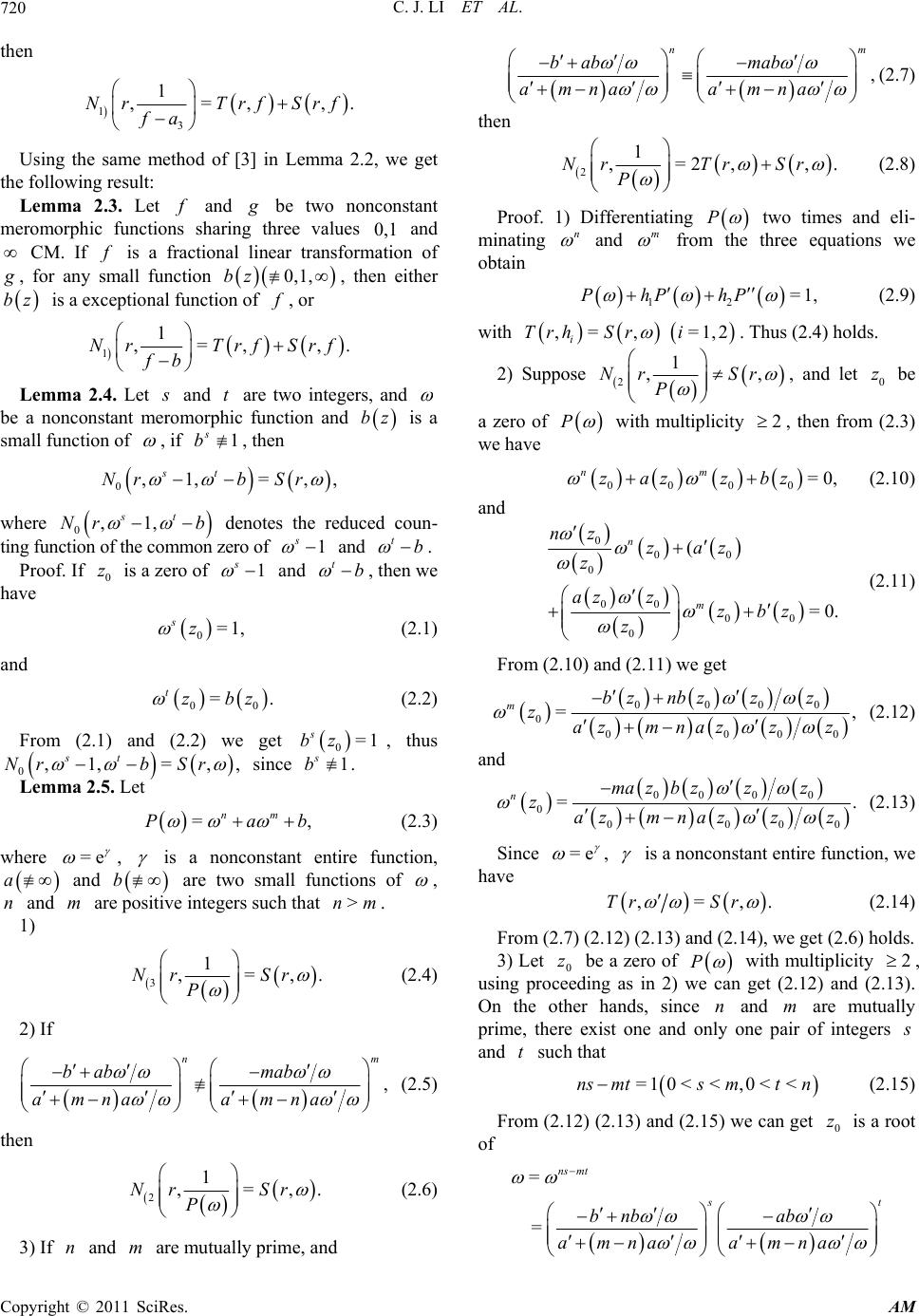 C. J. LI ET AL. 720 then 1 3 1 ,=, ,NrTrfSrf fa . Using the same method of [3] in Lemma 2.2, we get the following result: Lemma 2.3. Let and f g be two nonconstant meromorphic functions sharing three values and CM. If is a fractional linear transformation of 0,1 f g , for any small function bz 0,1, f , then either is a exceptional function of , or bz 1 1 ,=,,NrTrf Srf fb . Lemma 2.4. Let s and t are two integers, and be a nonconstant meromorphic function and bz is a small function of , if , then 1 s b 0,1, =, st Nrb Sr, where denotes the reduced coun- ting function of the common zero of and 0,1, st Nr b 1 s tb . Proof. If is a zero of and , then we have 0 z1 s t b 0=1, sz (2.1) and 0 = tzbz 0 . , (2.2) From (2.1) and (2.2) we get , thus 0=1 s bz 0,1, =, st Nrb Sr since . 1 s b Lemma 2.5. Let = nm Pa ,b (2.3) where =e , is a nonconstant entire function, a and b are two small functions of , and m are positive integers such that . n>nm 1) 3 1 ,=,.Nr Sr P (2.4) 2) If , n bab mab amna amna m (2.5) then 2 1 ,=,Nr Sr P. (2.6) 3) If and are mutually prime, and n m , nm bab mab amnaamna (2.7) then 2 1 ,=2, ,NrTr Sr P. (2.8) Proof. 1) Differentiating P two times and eli- minating n and m from the three equations we obtain 12 =1,PhP hP (2.9) with ,=, =1,2 i Trh Sri . Thus (2.4) holds. 2) Suppose 2 1 ,NrSr P , , and let be 0 z a zero of P with multiplicity , then from (2.3) we have 2 0000 =0, nm zaz zbz (2.10) and 0 00 0 00 00 0 ( =0. n m nz zaz z az zzbz z (2.11) From (2.10) and (2.11) we get 0000 0 000 =, mbz nbzzz zaz mnazzz 0 (2.12) and 00 00 0 000 =. nma zb zzz zaz mnazzz 0 (2.13) Since =e , is a nonconstant entire function, we have ,=,TrSr . (2.14) From (2.7) (2.12) (2.13) and (2.14), we get (2.6) holds. 3) Let 0 be a zero of z P with multiplicity , using proceeding as in 2) we can get (2.12) and (2.13). On the other hands, since and are mutually prime, there exist one and only one pair of integers 2 n m s and t such that =1 0<<,0<<ns mtsmtn (2.15) From (2.12) (2.13) and (2.15) we can get is a root of 0 z = = ns mt s t bnb ab amna amna Copyright © 2011 SciRes. AM 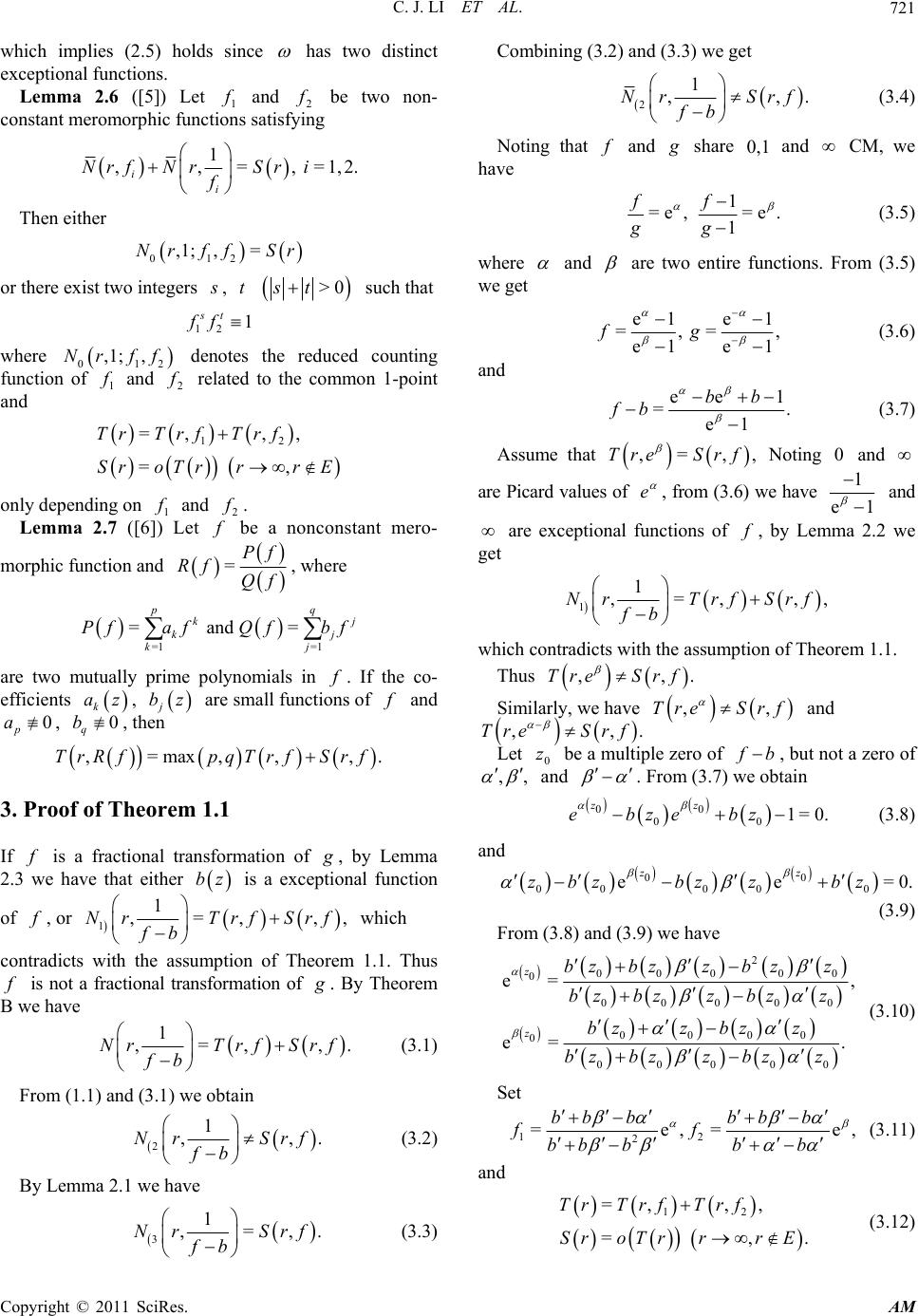 C. J. LI ET AL.721 which implies (2.5) holds since has two distinct exceptional functions. Lemma 2.6 ([5]) Let 1 and 2 be two non- constant meromorphic functions satisfying f f 1 ,,=, = ii NrfNrSr i f 1,2. Then either 012 ,1; ,=NrffSr or there exist two integers s , t >0st such that 12 1ff st where 2 denotes the reduced counting function of and related to the common 1-point and 01 ,1; ,Nr ff 1 f2 f 12 =,,, = , Tr TrfTrf SroTrrr E only depending on and . 1 2 Lemma 2.7 ([6]) Let be a nonconstant mero- f f f morphic function and =Pf Rf Qf , where =1 =1 = and = pq kj k kj PfafQfbf j are two mutually prime polynomials in . If the co- efficients f k az, j bz are small functions of and , , then f 0 p a 0 q b ,=max,, ,TrRfpqTrfSrf. 3. Proof of Theorem 1.1 If is a fractional transformation of f g , by Lemma 2.3 we have that either is a exceptional function bz of , or f 1 1 ,=,, NrTrf Srf fb , which contradicts with the assumption of Theorem 1.1. Thus is not a fractional transformation of f g . By Theorem B we have 1 ,=,,. (3.1) NrTrf Srf fb From (1.1) and (3.1) we obtain 2 1 ,Nr Srf fb ,. (3.2) By Lemma 2.1 we have 3 1 ,=,NrSrf fb Combining (3.2) and (3.3) we get 2 1 , Nr Srf fb , . (3.4) Noting that and f g share 0,1 and CM, we have 1 =e, =e. 1 ff gg (3.5) where and are two entire functions. From (3.5) we get e1e 1 =, = e1e 1 fg , (3.6) and ee1 = e1 bb fb . (3.7) Assume that ,=,Tre Srf , Noting 0 and are Picard values of , from (3.6) we have e1 e1 and are exceptional functions of , by Lemma 2.2 we get f 1 1 ,=,,NrTrf Srf fb , which contradicts with the assumption of Theorem 1.1. Thus ,,TreSrf . Similarly, we have ,Tre Srf , and ,,Tre Srf z.fb Let 0 be a multiple zero of , but not a zero of ,, and . From (3.7) we obtain 00 00 1=0. zz ebzebz (3.8) and 00 00 000 ee zz zbzbz zbz =0. (3.9) From (3.8) and (3.9) we have 2 000 00 0 00000 0000 0 00000 e= e= . z z bzbzzbzz bz bzz bzz bzz bzz bz bzz bzz , (3.10) Set 12 2 =e, = bb bbb b ff bb bb be, (3.11) and 12 =, ,, = , Tr TrfTrf SroTrrr E . (3.12) . (3.3) Copyright © 2011 SciRes. AM 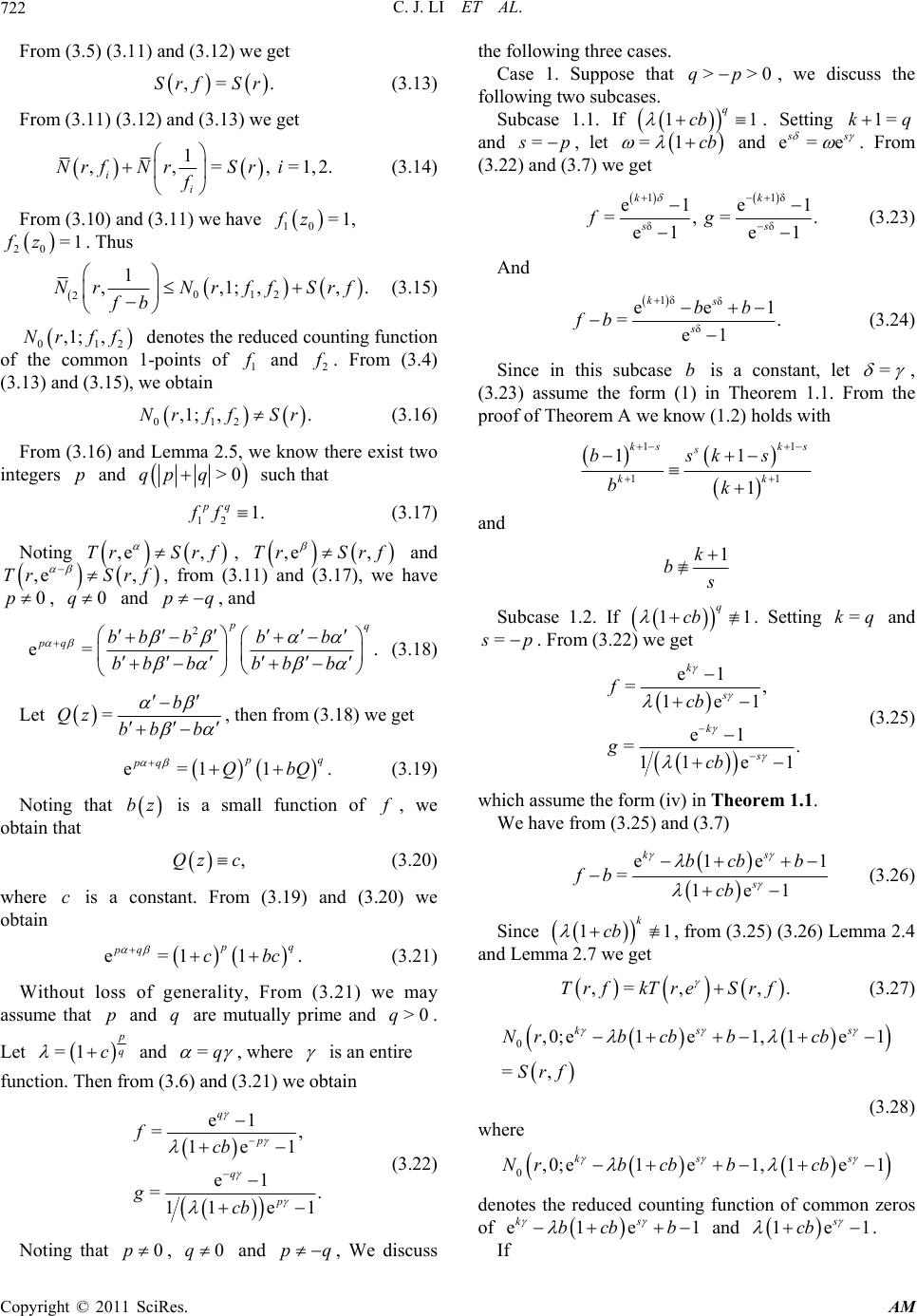 C. J. LI ET AL. 722 . From (3.5) (3.11) and (3.12) we get ,=SrfSr (3.13) From (3.11) (3.12) and (3.13) we get 1 ,,=, =1,2 ii NrfNrSr i f . (3.14) From (3.10) and (3.11) we have . Thus 10 =1,fz 20 =1fz 012 2 1 ,,1;,NrNrff Srf fb ,. (3.15) 01 ,1; ,Nr ff 2 denotes the reduced counting function of the common 1-points of 1 f and 2 f . From (3.4) (3.13) and (3.15), we obtain 012 ,1; ,.Nr ffSr (3.16) From (3.16) and Lemma 2.5, we know there exist two integers and p >0qp q such that 12 1. pq ff (3.17) Noting , and , from (3.11) and (3.17), we have , and , and ,e ,Tr Srf ,Srf 0pq ,e ,TrSrf ,eTr 0pq 2 e= pq pq bbbbb bb bbb b . (3.18) Let =b Qz bbb . , then from (3.18) we get e=11 p q pq QbQ (3.19) Noting that is a small function of , we obtain that bz f ,Qz c (3.20) where is a constant. From (3.19) and (3.20) we obtain c e=11. p q pq cbc (3.21) Without loss of generality, From (3.21) we may assume that and are mutually prime and . p q>0q Let =1 p q c and q=, where is an entire function. Then from (3.6) and (3.21) we obtain e1 =, 1e1 e1 =. 11 e1 q p q p fcb gcb (3.22) Noting that , and , We discuss the following three cases. 0p0qqp Case 1. Suppose that , we discuss the following two subcases. 0>>pq Subcase 1.1. If 1 q cb 1 . Setting 1=kq and p s =, let =1cb and e=e s s . From (3.22) and (3.7) we get 11δ δ e1e =, = e1e 1 kk ss fg δ 1 . (3.23) And 1δδ δ ee =. e1 ks s bb fb 1 (3.24) Since in this subcase b is a constant, let =, (3.23) assume the form (1) in Theorem 1.1. From the proof of Theorem A we know (1.2) holds with 11 11 11 1 ks ks s kk bsks bk and 1k b s Subcase 1.2. If 1 q cb 1 . Setting and qk = = s p . From (3.22) we get e1 =, 1e1 e1 =. 11e 1 k s k s fcb gcb (3.25) which assume the form (iv) in Theorem 1.1. We have from (3.25) and (3.7) e1e =1e1 ks s bcb b fb cb 1 1 (3.26) Since 1 k cb , from (3.25) (3.26) Lemma 2.4 and Lemma 2.7 we get ,= ,,Trf kTreSrf . (3.27) 0,0;e1e 1,1e =, ks Nrbcbbcb Srf 1 s (3.28) where 0,0;e1e 1,1e ks Nrbcbbcb 1 s denotes the reduced counting function of common zeros of e1e ks bcb b 1 1 and . 1e s cb If Copyright © 2011 SciRes. AM 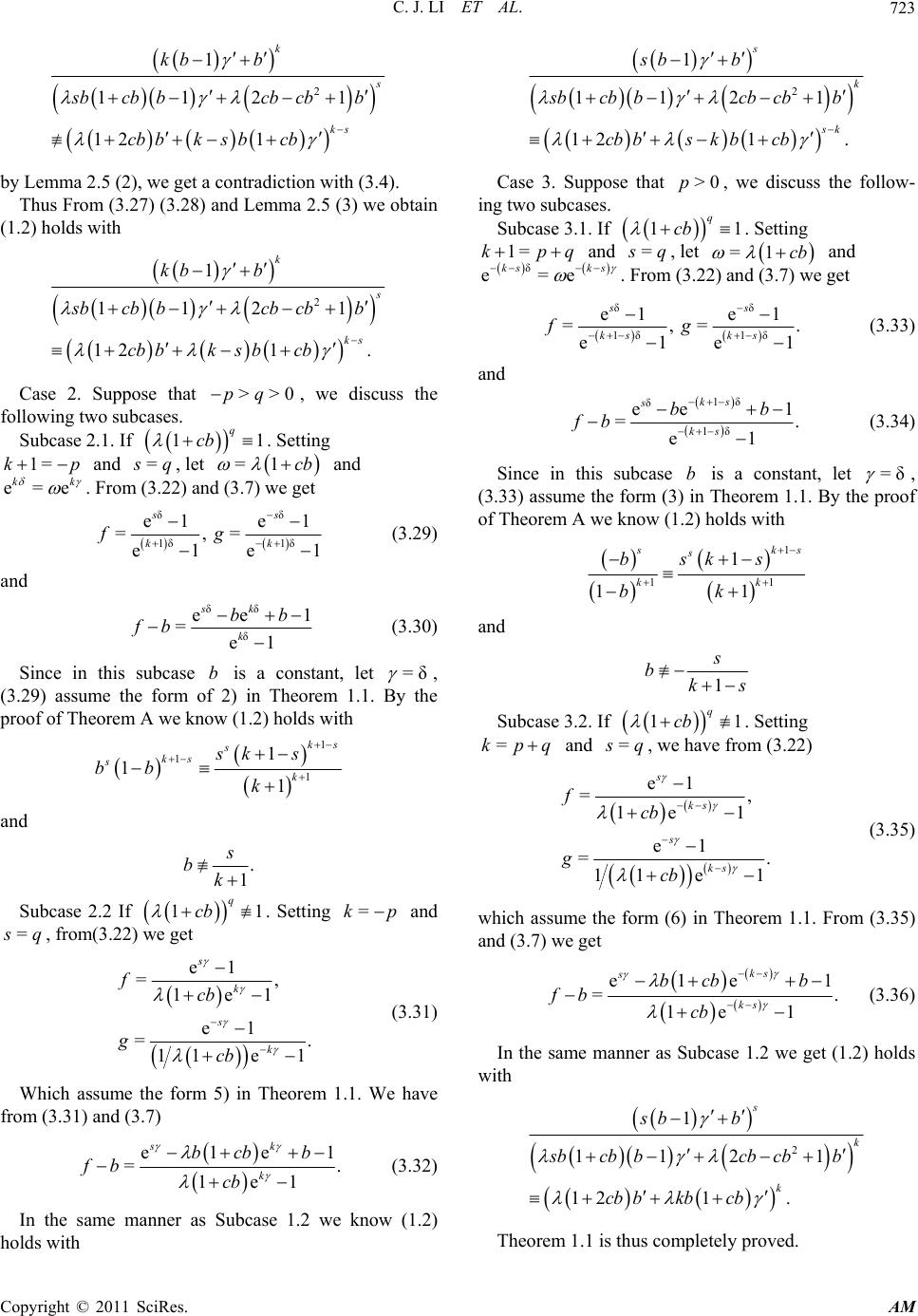 C. J. LI ET AL.723 2 1 112 1 12 1 k s ks kb b s bcbbcb cbb cb bks bcb by Lemma 2.5 (2), we get a contradiction with (3.4). Thus From (3.27) (3.28) and Lemma 2.5 (3) we obtain (1.2) holds with 2 1 112 1 121 . k s ks kb b s bcbbcb cbb cb bks bcb Case 2. Suppose that , we discuss the following two subcases. >>0pq Subcase 2.1. If . Setting and 11 q cb =1=kp s q=1 , let and cb k e=e k . From (3.22) and (3.7) we get δδ 1δ1δ e1e 1 =, = e1e ss kk fg 1 (3.29) and δδ δ ee =e1 sk k bb fb 1 (3.30) Since in this subcase is a constant, let b=δ , (3.29) assume the form of 2) in Theorem 1.1. By the proof of Theorem A we know (1.2) holds with 1 1 1 1 1 1 ks s ks s k sk s bb k and . 1 s bk Subcase 2.2 If . Setting 1 q cb 1p=k and = s q, from(3.22) we get e1 =, 1e1 e1 =. 11e1 s k s k fcb gcb (3.31) Which assume the form 5) in Theorem 1.1. We have from (3.31) and (3.7) e1e =. 1e1 sk k bcbb fb cb 1 (3.32) In the same manner as Subcase 1.2 we know (1.2) holds with 2 1 112 1 121 . s k sk sb b s bcbbcb cbb cb bskbcb Case 3. Suppose that , we discuss the follow- ing two subcases. >0p Subcase 3.1. If 1 q cb 1 . Setting 1=kpq and = s q , let and =1cb δ e= ks e ks . From (3.22) and (3.7) we get δδ 1δ1δ e1e 1 =, = e1e ss ks ks fg . 1 (3.33) and 1δ δ 1δ ee 1 =. e1 ks s ks bb fb (3.34) Since in this subcase b is a constant, let =δ , (3.33) assume the form (3) in Theorem 1.1. By the proof of Theorem A we know (1.2) holds with 1 11 1 11 s ks s kk bsks bk and 1 s bks Subcase 3.2. If 1 q cb 1 . Setting =kpq and = s q, we have from (3.22) e1 =, 1e1 e1 =. 11 e1 s ks s ks fcb gcb (3.35) which assume the form (6) in Theorem 1.1. From (3.35) and (3.7) we get e1e =. 1e1 ks s ks bcbb fb cb 1 (3.36) In the same manner as Subcase 1.2 we get (1.2) holds with 2 1 112 1 121 . s k k sb b s bcbbcb cbb cb bkbcb Theorem 1.1 is thus completely proved. Copyright © 2011 SciRes. AM 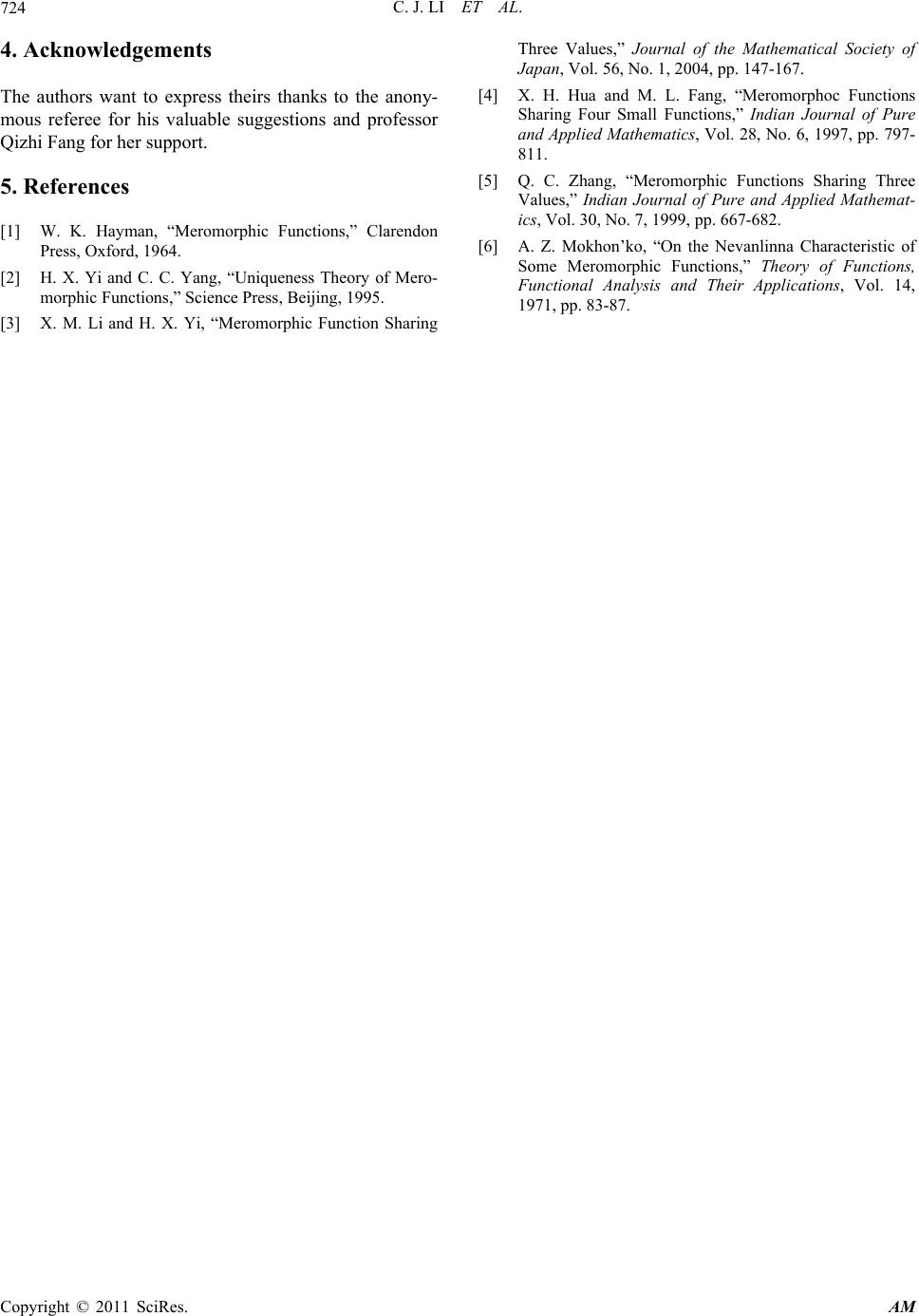 C. J. LI ET AL. Copyright © 2011 SciRes. AM 724 4. Acknowledgements The authors want to express theirs thanks to the anony- mous referee for his valuable suggestions and professor Qizhi Fang for her support. 5. References [1] W. K. Hayman, “Meromorphic Functions,” Clarendon Press, Oxford, 1964. [2] H. X. Yi and C. C. Yang, “Uniqueness Theory of Mero- morphic Functions,” Science Press, Beijing, 1995. [3] X. M. Li and H. X. Yi, “Meromorphic Function Sharing Three Values,” Journal of the Mathematical Society of Japan, Vol. 56, No. 1, 2004, pp. 147-167. [4] X. H. Hua and M. L. Fang, “Meromorphoc Functions Sharing Four Small Functions,” Indian Journal of Pure and Applied Mathematics, Vol. 28, No. 6, 1997, pp. 797- 811. [5] Q. C. Zhang, “Meromorphic Functions Sharing Three Values,” Indian Journal of Pure and Applied Mathemat- ics, Vol. 30, No. 7, 1999, pp. 667-682. [6] A. Z. Mokhon’ko, “On the Nevanlinna Characteristic of Some Meromorphic Functions,” Theory of Functions, Functional Analysis and Their Applications, Vol. 14, 1971, pp. 83-87. |

